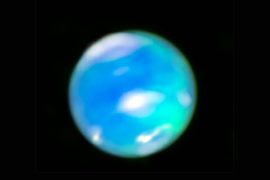Two bays on the coast of Vietnam

Two bays on the coast of Vietnam. Today’s Image of the Day from NASA Earth Observatory features Hạ Long Bay and Bai Tu Long Bay along the northeast coast of Vietnam.
Hạ Long Bay is a protected World Heritage Site that is known for its natural beauty. This region consists of about 1,600 islands and islets and an abundance of rainforest. Most of the islands are steep and uninhabitable.
In the northeast, Bai Tu Long Bay National Park contains 40 islands and almost 2,000 species of plants and animals. The park is home to broad-leaved rainforests, coral reefs, and shallow water areas.Archaeological excavations indicate that Vietnam was inhabited as early as the Paleolithic age. The ancient Vietnamese nation, which was centered on the Red River valley and nearby coastal areas, was annexed by the Han dynasty in the 2nd century BC, which subsequently made Vietnam a division of Imperial China for over a millennium. The first independent monarchy emerged in the 10th century AD.
This paved the way for successive imperial dynasties as the nation expanded southward until the Indochina Peninsula was colonised by the French in the late 19th century. Modern Vietnam was born upon the Proclamation of Independence from France in 1945. Following Vietnamese victory against the French in the First Indochina War, which ended in 1954, the nation was divided into two rival states.
The image was captured on November 12, 2020 by the Operational Land Imager (OLI) on Landsat 8.
Image Credit: NASA Earth Observatory
—
By Chrissy Sexton, Earth.com Staff Writer
News coming your way





















